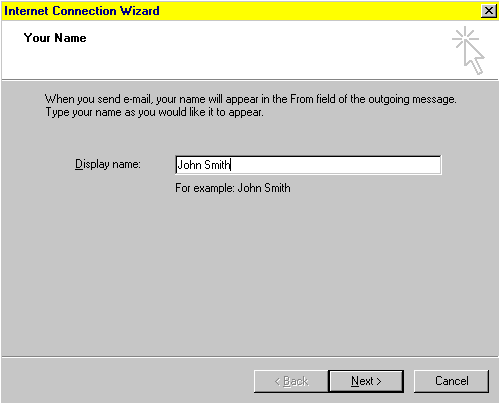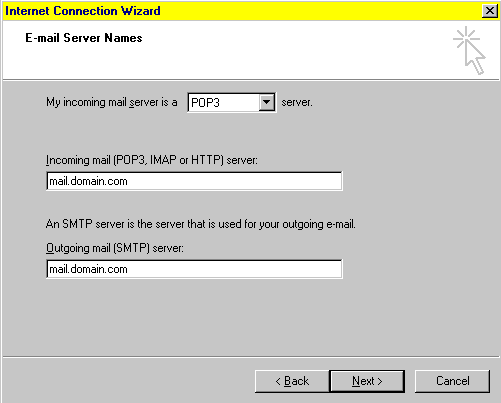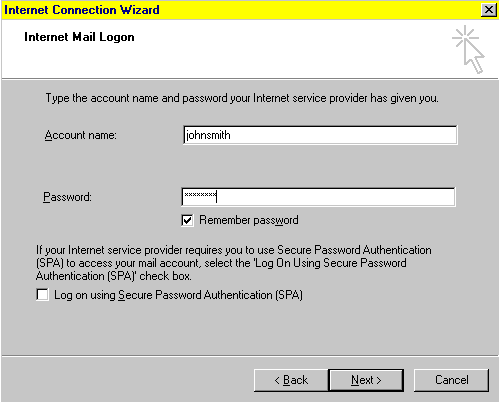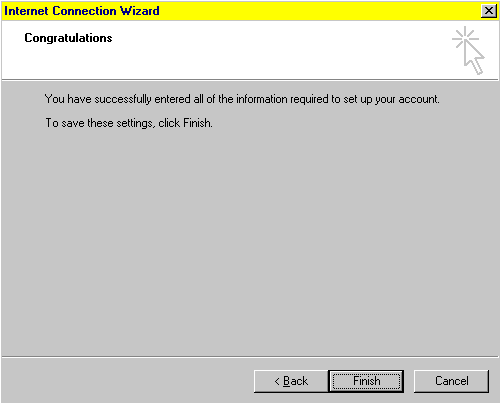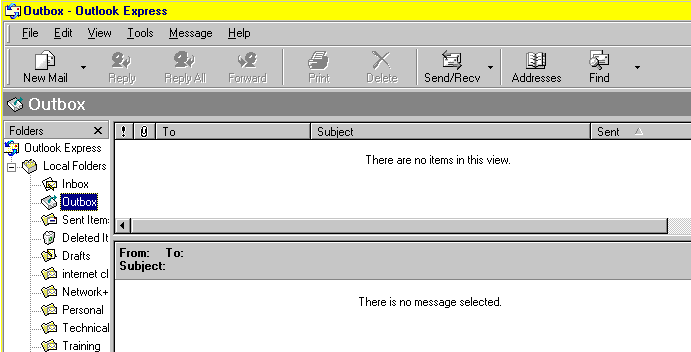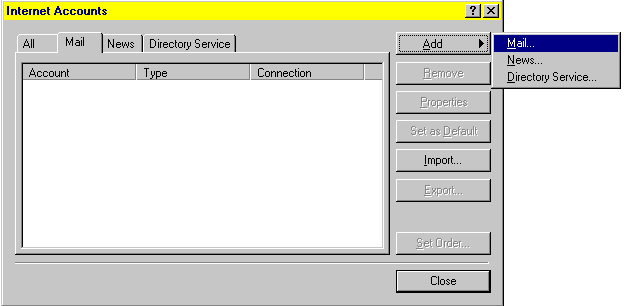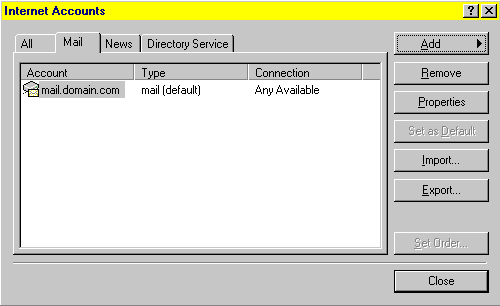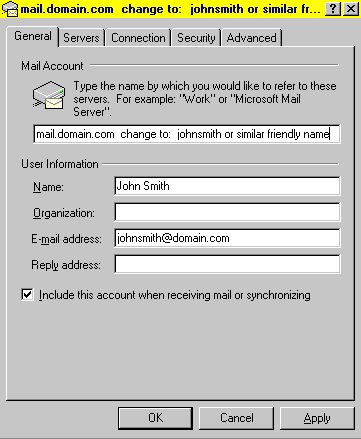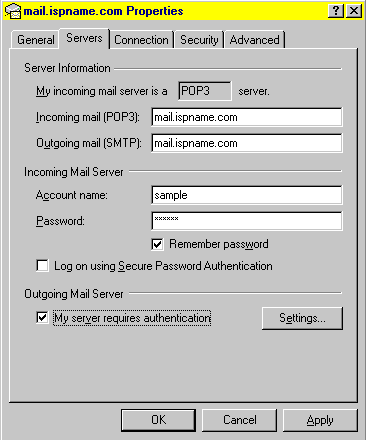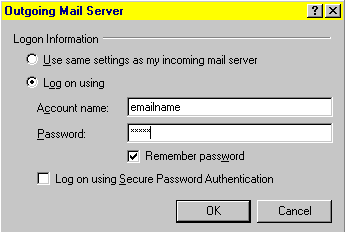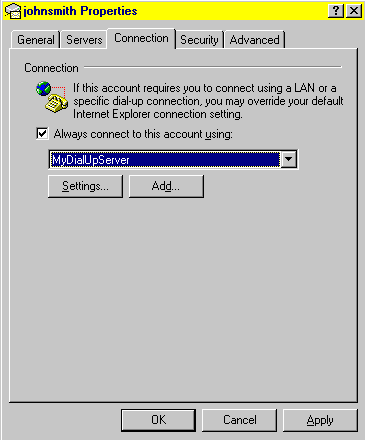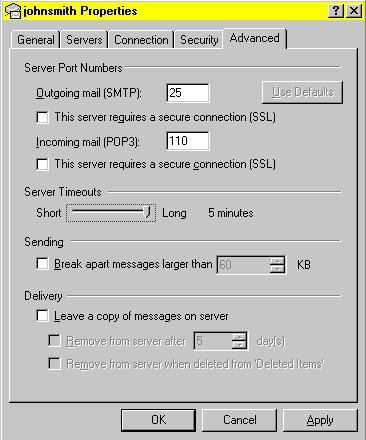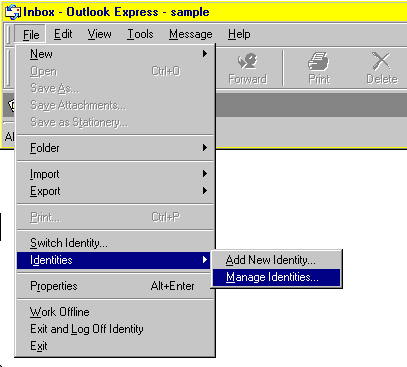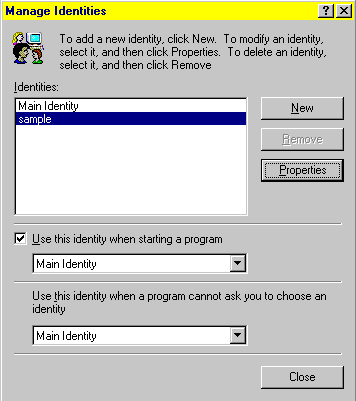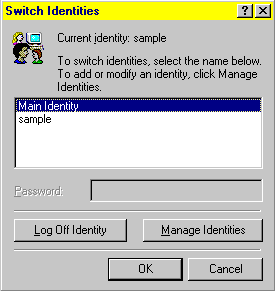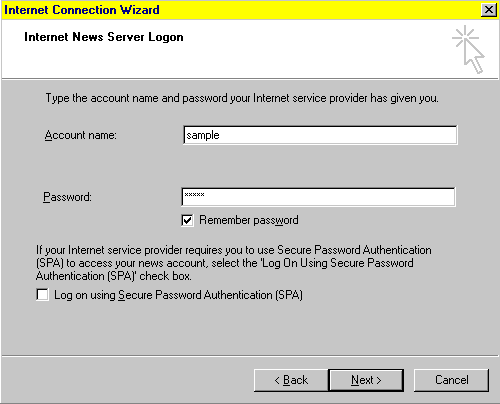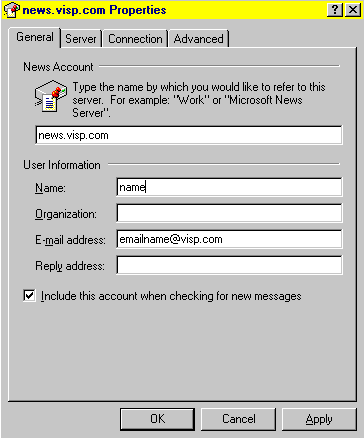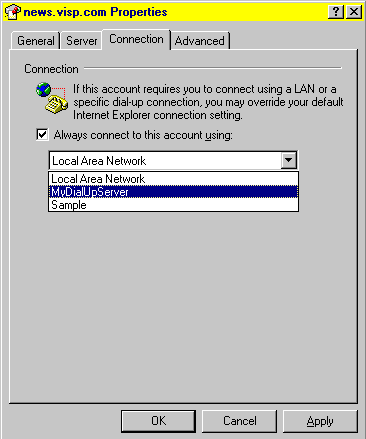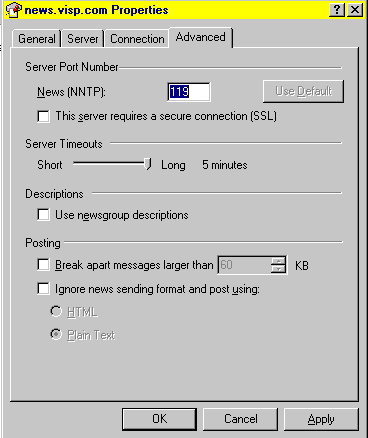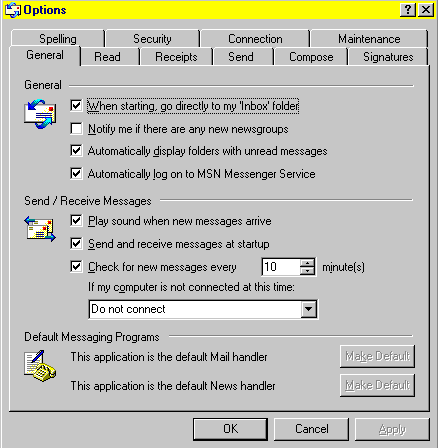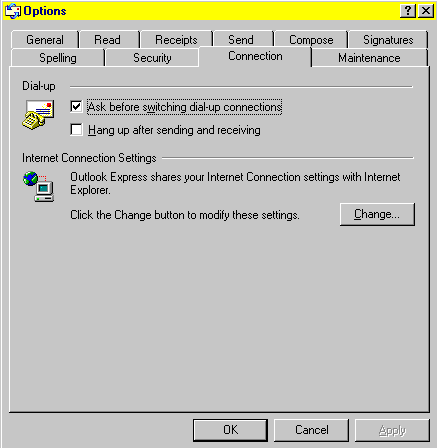|
|

|
|
|
Quick Links: | OE5 Mail Account Setup Wizard | Tools Accounts: Setup & Configure E-Mails | Profile Management | News Servers | Tools Options | OE Won't Save Password | Zen Summary: Tools Menu -> Accounts Option These configuration instructions apply to PC versions of Outlook Express 5 (OE5). Go to the Macintosh section for Outlook Express screen shots for that operating system. OE5 is probably the best mail client available for free at places like www.tucows.com and www.download.com. You can download the 500 KB file without downloading the other 10+ MB of files from Internet Explorer. It also comes with the full IE5 download. It is almost always recommended that you upgrade from OE4 even if you are worried about hard disk space. The OE5 component is small and it will automatically import old addresses, etc., from the earlier versions of Outlook Express. OE5 is a great program because you can easily setup multiple profiles for everybody in the family. Each profile can check a bunch of different e-mail addresses. You can also password protect each profile for privacy in the family. Each of these options are covered in this document.
OE5 Mail Account Setup Wizard: The OE5 Setup Wizard runs automatically the first time that you use OE5. It also runs when you go into Tools -> Accounts -> Mail Tab and click the "add" button to create a new mail account. Start by filling in the display name. This is the name that people will see when they receive a mail from you. The name does not have to match the e-mail username. Click "next" when you are finished with this simple step. <next>
Put your full e-mail address in the address box. Make sure that you don't put any spaces in there. Make sure that you don't put "at" instead of the "@" symbol. Click next.
Make sure that you leave the e-mail set for a POP3 server. The incoming and outgoing mail server address can be something like mail.ispname.com or it can be an IP number. Click next.
The "account name" is the e-mail logon. It is almost always the same as the first part of your e-mail address although it is possible to use a different name. The password will look like little xxxxxxx because the password will be encrypted. It is generally convenient to put a checkmark in the "remember password" box. Privacy can be maintained with a password protected profile as covered in the profile management section of this tutorial. Do NOT put a checkmark in the "log on using secure password authentication" section unless you are running a virtual domain mail server that is specifically setup for encryption (which is very unusual and costs extra). Click next.
Click "finish" but remember that you will still need to go to the Tools -> Accounts section for additional configuration. <next>
Once you have finished the setup wizard, you will go straight to the Internet Accounts window as covered in the next section. <next: tools-accounts> <return to top>
Tools Menu -> Accounts Button: Creating & Configuring E-Mail Accounts Quick Links: | E-Mail Accounts | General Tab | Servers Tab | Connection Tab | Advanced Tab | The basic OE5 window is pictured below. Please note that the following example is showing the outbox window. Click on the inbox window or whichever folder is desired from the drop-down box on the left.
Click the "tools" menu to access the address book, accounts and/or options section. We need to go to the accounts section to create or configure individual e-mail settings. <next>
Once you are in the accounts section, click on the mail tab to see all existing e-mail settings. Be sure to delete obsolete internet accounts for old ISPs. They will generate errors if you run OE5 because the old ISPs will reject your attempt to check non-functioning e-mails. You can highlight any accounts listed in the box and then hit the remove button to clear them out. Hit the "properties" button to edit any accounts that are still functional. If you click the "add" button and choose the "mail" option then you will go into the OE5 setup wizard which is covered in an earlier section. Click here to see those screen shots or continue below to configure an already created e-mail account. <next>
Newly created e-mail accounts will be identified by their mail server addresses. For example, if you setup three @ispname.com e-mail accounts in OE5, they will be identified as mail.ispname.com(1), mail.ispname.com(2) and mail.ispname.com(3). Needless to say, this isn't a very intuitive naming scheme. Open your properties for each account and rename the accounts with the appropriate e-mail username for easy identification later.
Properties: General Tab The properties section has five tabs. We will start in the general tab where you can rename accounts such as mail.ispname.com(1) into a more intuitive name such as the e-mail username. The top box is where that name gets set. Don't forget to hit the "apply" button to make this or any other change. The "user information" section is where you set or change the name that people see when you send them an e-mail from this account. It is also where you set the e-mail address. Leave the "reply address" blank unless you want to reply from a different e-mail account (which is unusual for our clients). Don't forget the checkmark to include this account when sending or receiving mail. You also need to hit the "apply" button to make changes effective.
Below: An example of the name having been changed in the top box of the preceding screen. The johnsmith account had originally been named mail.domain.com after its mail server address. Now it has a more easily recognizable name. This is helpful if there are several different e-mail identities using the same mail server address.
Properties: Servers Tab
The servers tab is where you set the mail server addresses. This is the most prevalent cause of mail client connection problems so it is usually the first thing that you would need to check. The mail server address will always follow this format: mail.ispname.com [or .net]. You can also use the mail server's IP address if you are having DNS problems. [Advanced Tip: You can open the MS-DOS Prompt to ping a mail server for its IP address.] You also set the e-mail username and password. This e-mail username is often different than the dial-up username since families will use a single dial-up username and multiple different e-mail identities. Do NOT put a checkmark in the "log on using secure password authentication" box. This involves encryption that will only work on virtual domain mail servers that have paid extra for encryption that is specifically setup by for that account at an extra cost. You do want a checkmark in "My server requires authentication" so click in that box to add one if needed. Click the "Settings" button to get to the following window. Select the option to "Log on using" and put in your e-mail name and password. Do not choose "Log on using Secure Password Authentication." Click the OK button.
"Apply" changes and click on the connection tab when finished. <next: connection tab>
Properties: Connection Tab The connection tab is where you can setup OE5 to automatically connect to your ISP when opening OE5. Put a checkmark in the box. Click the drop-down arrow to choose your ISP DUN connection. That drop-down list will show every DUN connection that is setup in the dial-up networking section of your computer. You can also click the "settings" button to change the DUN settings or the "add" button to create a new dial-up networking account. Hit "apply" when finished and skip the "security" tab to go to the "advanced" tab for one last important tweak on the configuration. <next: advanced tab>
Properties: Advanced Tab The "advanced" tab is where you can maximize the server timeout setting for OE5. The default is 1 minute but you will want to "tweak" that all the way to its maximum of five minutes for improved performance handling larger volumes of e-mail and possibly larger attachments. We strongly discourage you from leaving a copy of messages on the server. OE5 will do this effectively for a while but it will eventually start reporting that there are "no new messages" even though there are new messages. The problem is caused by OE5 seeing old messages at the top of the list and assuming that the rest of the messages are also old. Make sure that you do NOT put a checkmark for the SSL secure connection options unless you are running a virtual domain that is specifically setup with a secure SSL mail server. [This is highly unusual with standard internet connections.] Hit "apply" and then "ok" to finish the configuration. You are ready to check your e-mail unless you need to setup additional e-mail identities. In the latter case, repeat the steps covered in this section for each e-mail account. Remember: It is often preferable to use the profile manager to setup an identity for each member of the household. Each profile can have numerous e-mail accounts. Individual profiles can be password protected so that family members can have their privacy. Using a single profile for multiple family members will result in everyone's e-mail showing up when one of the family checks his e-mail.
Profile Management For OE5 Most families prefer to use the profile manager to setup an identity for each member of the household. Each profile can have numerous e-mail accounts. Individual profiles can be password protected so that family members can have their privacy. Using a single profile for multiple family members will result in everyone's e-mail showing up when one of the family checks his e-mail. Click the file menu to setup profile management. Choose "identities" -> "manage identities" to setup the various profiles. You can also use the file menu to "switch identities" after the profiles have been setup. <next>
The "manage identities" box is pictured below. Highlight an identity and put a checkmark in "use this identity" to set the default identity. However, you won't be able to do that until multiple identities have been setup. Click the "new" button to create a new identity. Highlight old identities and hit the "properties" button to edit already existing identities. Either route will result in the screen shot following the one below. <next>
Type in a name for the profile. You can password protect each profile by placing a checkmark into the appropriate box. This will password protect each profile so that family members can have their privacy. This also enables them to "save password" for their various e-mail accounts so that they don't have to re-enter their password each time that they check their e-mail. <next>
When you click the "file menu -> switch identity" then you will get the following screen. If a profile is password protected then you will need to put in its password in the [grayed out example below] password box in order to login to that profile. You can also return to the profile manager by clicking on the "manage identities" box.
<next: news servers> <tools options> <return to top> <return to windows home page>
News Server Configuration: Most people don't use the news server capacity of their internet connection. Nevertheless, you can configure OE5 to check various newsgroups. Open Tools -> Accounts in OE5 then click "add" button and choose "news" as shown below. <next>
The news server wizard will prompt you for the news server address. It always follows this format: news.ispname.com. You can also use an IP address for that news server. Effective June 2002, you will need to click in the little box to put a checkmark where it says "My news server requires me to log on." This is need to fight spamming on the Internet. Hit next and then finish. Simple setup but you still need to check the news server properties as described below the following screen shot. <next>
The account name box should have your regular username (no domain tail) that you use to login to our Internet. The password also needs to be plugged in. The checkmark for "Remember password" is also handy. Click Next when ready.
Once you've created a news group client, you will need to configure its properties. Click on Tools -> Accounts -> News Tab. Highlight the identity and hit the properties button to get to the screen below. The general tab is where you name the identity and specify the e-mail address associated with that identity. The name box is the identity that people will see if you "post" data to a news group out there on the Web. Click the server tab after applying any changes. <next>
The news server address always follows this format: news.ispname.com. You can also use your news server's IP address if you know it. Effective June 2002, you will need to click in the little box to put a checkmark where it says "This server requires me to log on." This is need to fight spamming on the Internet. Once you've got a checkmark in that box, you will be able to put in your username (no domain tail) and password. Make sure that you don't select "log on using secure password authentication" because we don't have any encryption capabilities on our news server. <next>
The connection tab is where you setup OE5 to automatically connect to our DUN connection when needed. The drop-down list will have every connection that is configured in the Dial-Up Networking section of their workstation. You can actually add or edit those DUN connections from buttons below the drop-down list. [The following example has those buttons covered by the drop-down list but they are there.] <next>
The advanced tab is where you would "tweak up" the configuration by setting the "server timeouts" to their maximum value of five minutes. This will give OE5 more time to download a larger number of news group postings. Leave the port number at its default 119. Don't bother with the other options. Hit "apply" (if needed) and "ok" to return to the Tools -> Accounts windows. <next: tools -> options> <return to top>
Tools -> Options Configuration The Tools -> Options window is where you can set a variety of options. Browse around and set things as you like them. The only options that we are concerned about are shown below. The general tab is where you set OE5 to go directly to its inbox when started. Most people want this but it isn't required. You can also set OE5 to play a sound when new messages are received. You can automate OE5 to connect to the internet through any ISP by clicking the drop-down list (where it says "do not connect" in the example below). Most people will want that set to connect automatically. You probably don't want to check for new messages more often than once every ten minutes. More frequent e-mail checks will put a lot of overhead on your computer and slow down your connection and programs. Hit "apply" if needed then check the connection tab. <next>
There is one potential problem spot in the connection tab. Sometimes, customers will complain that we disconnect them every time they send or receive mail. We don't disconnect anybody for a minimum of six hours. The checkbox for "hang up after sending and receiving" is the culprit so don't put a checkmark in that box. <next>
That is everything you need to know about configuring the PC version of OE5. If you still cannot check your e-mail then try using Internet Explorer or Netscape to access the Web interface to your e-mail. <return to top> <return to windows home page>
Last Update: Thursday, July 03, 2003
|
